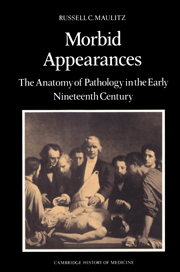Conclusion: A language of morbid appearances
Published online by Cambridge University Press: 22 September 2009
Summary
I have tried in this account to provide evidence for the proposition that ideas spread unevenly. Medical traditions are influenced by chance and by context. How, for example, can one account for the differential reception of Bichatian pathology in France and England? And how did pathological anatomy become entrenched in different degrees and ways in different parts of Napoleonic Europe? Various explanations suggest themselves. Perhaps, for example, the science of pathology took different turns on opposite shores of the channel because the material biological reality itself differed between London and Paris.
According to this explanation, patterns of disease would offer sufficiently disparate stimulus to the medical imagination to create ultimately quite different explanatory frameworks. Tissue pathology, for example, might have emerged where there was an isolated superabundance of disease of the serous and mucous membranes, a state of affairs known to exist in the Paris of 1800. Or the new laboratory discipline of toxicology and its sibling, experimental physiology, might have emerged where there was a conspicuous excess of poisoning and newly discovered poisonous materials. This sort of material argument, though attractive, fails finally to persuade. There is too little evidence to suggest that patterns of morbidity and mortality varied significantly between Paris and the urban and military concentrations in Britain or elsewhere.
- Type
- Chapter
- Information
- Morbid AppearancesThe Anatomy of Pathology in the Early Nineteenth Century, pp. 224 - 229Publisher: Cambridge University PressPrint publication year: 1987

